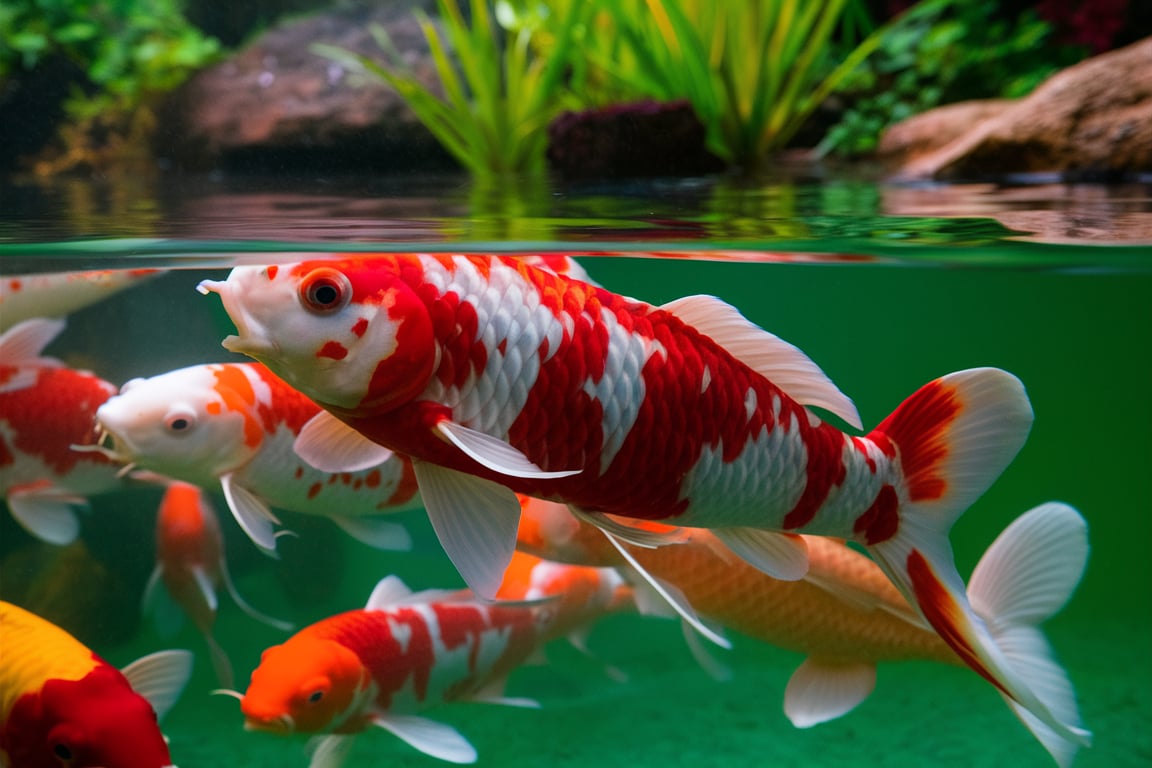In the captivating world of Love My Koi, the Goromo Koi Fish stands out as a true masterpiece of nature and human artistry. This stunning variety, with its intricate patterns and vibrant hues, is a testament to the dedication and skill of Japanese breeders who have meticulously crafted these aquatic gems over centuries.
Understanding Goromo Koi Fish: A Deeper Dive

Goromo Koi, which translates to “robe” or “garment” in Japanese, is a highly sought-after variety known for its unique and complex patterns. These patterns, often described as “tapestry-like,” are a result of selective breeding and meticulous care, creating a visual spectacle that captivates koi enthusiasts worldwide.
The Origins of Goromo Koi
The Goromo Koi, like many other koi varieties, traces its roots back to the common carp, Cyprinus carpio, native to Asia. However, the Goromo Koi is a relatively recent development, originating in Japan in the early 20th century. Japanese breeders, driven by a passion for creating visually striking koi, carefully selected and bred carp with specific color patterns, resulting in the Goromo Koi we admire today.
The Distinctive Features of Goromo Koi Fish
The defining characteristic of Goromo Koi Fish is their intricate and multi-layered patterns. These patterns are often described as “tapestry-like” due to their complex interplay of colors and shapes. The most common patterns include:
1. “Hikarimono” (Metallic) Patterns:
- Characteristics: These Goromo Koi Fish feature metallic scales that shimmer and reflect light, creating a dazzling visual effect.
- Examples: Hikarimono Goromo Koi often display patterns like “Kin Gin Rin” (gold and silver scales) or “Matsuba” (pine needle scales).
2. “Doitsu” (Scaleless) Patterns:
- Characteristics: These Goromo Koi lack scales along their bodies, except for a small area near the head. This creates a unique and elegant appearance.
- Examples: Doitsu Goromo Koi often display patterns like “Doitsu Kohaku” (white body with red markings) or “Doitsu Showa” (black body with red and white markings).
3. “Tancho” (Single-Spot) Patterns:
- Characteristics: These Goromo Koi feature a single, distinct spot on their head, often in a contrasting color.
- Examples: Tancho Goromo Koi often display patterns like “Tancho Kohaku” (white body with a single red spot on the head) or “Tancho Showa” (black body with a single red spot on the head).
The Appeal of Goromo Koi Fish: More Than Just Beauty
Goromo Koi are not just visually stunning; they also hold a special appeal for koi enthusiasts due to their unique characteristics and symbolism:
1. Rarity and Value:
- Goromo Koi are relatively rare compared to other koi varieties, making them highly sought-after by collectors and enthusiasts. Their complex patterns and meticulous breeding require significant time, effort, and expertise, contributing to their value.
2. Symbolism and Meaning:
- Goromo Koi, with their intricate patterns, are often seen as symbols of wealth, prosperity, and good fortune in Japanese culture. Their complex designs and vibrant colors are believed to bring positive energy and good luck to their owners.
3. Aesthetic Appeal:
- Goromo Koi, with their tapestry-like patterns and shimmering scales, are a visual delight. They add a touch of elegance and sophistication to any pond or water garden, creating a captivating focal point.
Caring for Goromo Koi Fish: A Guide to Success
Caring for Goromo Koi Fish requires a dedicated approach and a deep understanding of their specific needs. Here are some key factors to consider:
1. Water Quality:
- Goromo Koi, like all koi fish, thrive in clean, well-oxygenated water. Regular water changes, filtration, and monitoring of water parameters are essential for their health and well-being.
2. Diet:
- A balanced diet is crucial for Goromo Koi to maintain their vibrant colors and patterns. A combination of high-quality koi pellets, vegetables, and occasional treats can provide the necessary nutrients.
3. Pond Environment:
- Goromo Koi require a spacious pond with adequate depth and filtration to ensure their comfort and health. A well-planted pond with hiding places provides a natural and stimulating environment.
4. Temperature:
- Goromo Koi are generally hardy fish, but they are sensitive to extreme temperature fluctuations. Maintaining a stable temperature range is important for their well-being.
Frequently Asked Questions About Goromo Koi Fish
1. What are Goromo Koi known for?
Goromo Koi are known for their intricate and multi-layered patterns, often described as “tapestry-like.”
2. Where do Goromo Koi originate from?
Goromo Koi originated in Japan in the early 20th century, developed through selective breeding.
3. What are the different types of Goromo Koi patterns?
Goromo Koi patterns include “Hikarimono” (metallic), “Doitsu” (scaleless), and “Tancho” (single-spot).
4. Why are Goromo Koi so valuable?
Goromo Koi are valuable due to their rarity, complex patterns, and the meticulous breeding process required to create them.
5. What does Goromo Koi symbolize?
Goromo Koi are often seen as symbols of wealth, prosperity, and good fortune in Japanese culture.
Conclusion: A Tapestry of Beauty and Tradition
Goromo Koi Fish, with their captivating patterns and vibrant colors, are a testament to the artistry and dedication of Japanese breeders. These stunning fish are not just visually appealing; they also hold a special place in Japanese culture and are highly valued by collectors and enthusiasts worldwide. By understanding their unique characteristics and needs, you can create a thriving environment for these beautiful creatures and enjoy their captivating presence in your pond or water garden.

Related Posts
Kikusui Koi Fish: A Symphony of Color and Elegance
Asagi Koi Fish: A Symphony of Blue and White in the Aquatic World
Red Koi Fish: A Vibrant Splash of Color in Your Pond